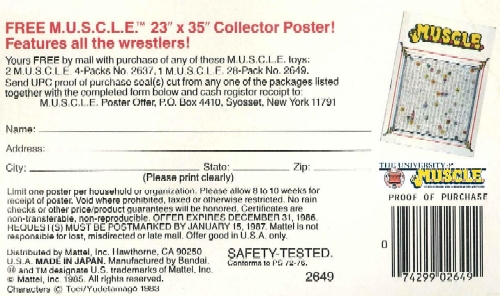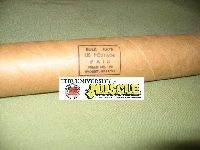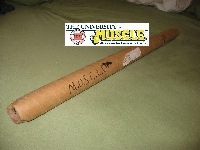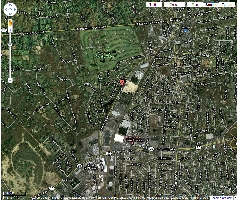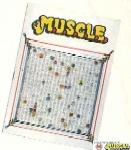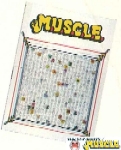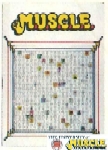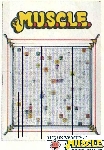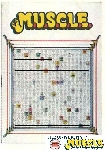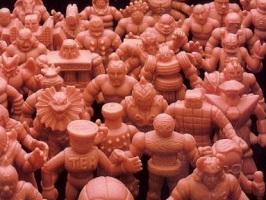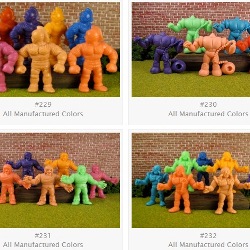The 28-packs and their contents are thoroughly examined as part of History 100. However, there is one piece of the 28-packs worthy of its own dissection – the poster offer, and for many collectors it is specifically the small picture accompanying the poster offer. No single piece of tangible M.U.S.C.L.E. information causes so much speculation. For many collectors it fuels the theory that all the Kinnikuman sculpts were originally slated for Mattel’s M.U.S.C.L.E. release. Others simply consider it a place-holding throwaway picture.
The offer appears simple and straightforward at first glance. Upon closer inspection the poster offer is teeming with data. The first sentence lists the M.U.S.C.L.E. products that must be purchased to be eligible to receive the poster, which are the 4- and 28-packs. The numbers that accompany the 4- and 28-packs in the first paragraph are the SKU’s from the Mattel Catalogs. It is interesting that the 10-pack was not accepted as part of the promotion.
Mattel was possibly concerned that customers would send in shredded proofs of purchase after tearing open the plastic-wrapped 10-packs. Another possibility was that the 10-pack did not mathematically fit into Mattel’s simple promotion idea: two 4-packs or one 28-pack equals a poster. Mattel may have assumed that customers would likely opt for the inexpensive 4-packs or the single 28-pack they had already bought – instead of the 10-pack.
The answer could be even simpler than either of those scenarios. The 10-pack packaging did not allow for the poster offer to be included on the packaging. This lack of space is clearly an issue on French-Canadian 4-packs.
Without space on both the 4- and 10-packs this could be a major contributing factor to the poster offer only being available in the United States – as stated in the second paragraph of the offer. Some, all, or parts of these issues may have influenced Mattel’s final decision regarding the proofs of purchase necessary to receive the poster.
Once the customer had the order form, cash register receipt and appropriate proof of purchases, they needed to send it off to a PO Box in Syosset, New York. The use of the PO Box is not surprising or uncommon for a promotion. A PO Box is normally located in the Post Office of the city from the address. If this is true, then the actual location of the Syosset Post Office is:
40 Queens St.
Syosset, NY 11791-3006
The location can be seen here on Google Maps plus some pictures and history of the Syosset Post Office can be seen at the Syosset Scrap Book website.
Knowing that the customer was sending the promotional poster offer to Syosset poses some serious questions:
- Who picked up the mailings?
- Where did they go?
- Who sent out the posters?
- Who made the posters?
Mattel’s closest known office was in East Aurora, New York – which is the Fisher-Price headquarters. These two locations are almost 400 miles apart, which makes it highly unlikely that East Aurora handled anything regarding the promotion. Mattel may have had offices in New York City during the mid-80’s, but tangible evidence to confirm this has not been discovered.
Assuming that Mattel did not have nearby offices, the next question becomes – where did these mailings go after they arrived in Syosset? Mattel had liked hired a contractor to handle the promotion. Unfortunately the contractor, or any further ideas, would be 100% conjecture.
One tangible piece of evidence regarding where the posters were sent out from has been uncovered. It is the mailing tube for the posters. Regrettably, there is not any identifying information regarding the source of the poster on the tube. It does appear that the posters were mailed to the customers from the Syosset Post Office as the Bulk Postage Paid stamp is from Syosset, NY. This is important because bulk mail must be mailed from the Post Office where the mailing permit is held. While it is possible the posters were printed in another location, it can be concluded that all of the handling of the poster offer took place in, or incredibly close to, Syosset, NY. John Delin, from A Syosset Scrapbook, attempted to help research further into the Syosset-M.U.S.C.L.E. connection. He contacted Tom Montalbano, a local historian, who as able to add this interesting anecdote:
“While I was growing up on the north side of town in the late 1970’s, there was a warehouse on Underhill Blvd that was packed with toys, including mini cars and trucks by Matchbox and Aurora. They may have stored other toys there, as well. I know about it primarily because, at some point, the warehouse was abandoned and a large trailer was left outside, packed with hundreds or thousands of Matchbox and Aurora cars…There’s a possibility that this warehouse was used by a Mattel distributor. Many of the buildings along that road have remained a mystery over the years.”
It does not appear that Matchbox was fully sold to Mattel until the late 1990’s. However, this does not mean that old stock did not end up at the facility. Nor does it mean that the location wasn’t used by several toy companies to defray costs – specifically for items that had been produced outside of the United States.
Returning back to the poster offer, Mattel provided the information necessary to mail the proofs of purchase, receipt, and order form. Beneath the order form are the promotion details and legal disclaimers. The first sentence points out that each household, or organization, can only receive one poster. This seems to be a very strange restriction for a non-contest promotion. Many similar promotions of the day (i.e., mail-away figures) did not have this same restriction.
This decision was likely a cost cutting decision. Mattel had likely allotted a certain, very limited, 1986 budget for the advertising which included the poster promotion. By placing a limit on the number of posters a household could receive, this helped to control the number of posters sent out and maximize the potential audience.
The disappearance of the poster offer from the packaging in 1987 is another sign that Mattel did not want to sink added finances into the M.U.S.C.L.E. brand. This cost cutting decision was a sign that both Mattel and M.U.S.C.L.E. were heading for problems.
The next four sentences are not very interesting. They state the standard legal statements that most promotions include. The fifth and sixth sentences deserve and evoke much more interest.
OFFER EXPERIES DECEMBER 31, 1986. REQUEST(S) MUST BE POSTMARKED BY JANUARY 15, 1987.
It is widely accepted that the first M.U.S.C.L.E. figures reached retail shelves in late 1985. It is also believed that those first packages of 4-packs and 28-packs did not have the poster offer. The poster offer likely appeared after the first production wave, likely on the packages of orders placed once M.U.S.C.L.E. appeared in the 1986 Mattel catalog. The poster offer expired at the end of 1986 and disappeared from packaging after the Flesh figures were fully discontinued and Color figures were fully integrated.
It appears that Mattel honored requests postmarked by January 15th, 1987, which would have been at the time of full Color figure integration. Using this data and recognizing the two versions of the poster (Flesh, Flesh & Color) it seems that Mattel initially sent out the Flesh posters. As the 50/50 Flesh and Color packages started shipping the Flesh poster was likely replaced with the Flesh & Color version. This also could have been because the initial printing of posters had been exhausted.
The 1987 release of M.U.S.C.L.E. was exclusively Color figures and did not include the poster offer. For further information on the M.U.S.C.L.E. posters, please look to Advertising & Promotion 100.
Lastly, Mattel included the standard blamelessness statement about the mail and that the offer was only honored in the United States. This exclusiveness, as suggested earlier, may have simply been the result of not having space on French-Canadian packaging. There could have been tax or postage issues as well.
Ultimately the greatest speculation still remains on the small, difficult to decipher, poster on the right side of the poster offer. There are three scanned versions of the poster below. An extreme close-up of the poster is not offered because the original picture is so small that extreme close-ups only distort the image beyond recognition, regardless of the resolution. The pictures below offer the best, still comprehendible, enlargements possible.
This difficult to see poster is most often used as the tangible evidence to suggest that Mattel wanted to make all 418 Kinnikuman figures, now called the “418 M.U.S.C.L.E. Figure Theory”. Closer inspections of the poster and Bandai’s Kinnikuman Parts and figure release dates have invalidated this theory.
The first damaging piece of data is that the poster has exactly 400 figures. As seen below the poster is made up of 20 vertical rows and 20 horizontal rows, which creates a grid of exactly 400 figures.
Proponents of the 418 M.U.S.C.L.E. Figure Theory would suggest that the remaining 18 figures were the sculpts that Mattel likely considered inappropriate for the line (e.g., Nazis). Unfortunately, this theory is nullified when the release dates of the Kinnikuman Parts are considered.
The entire M.U.S.C.L.E. line is made up of figures from Parts 1-21 of Bandai’s Kinnikuman. Mattel only could have worked on M.U.S.C.L.E. during the years of 1985, 1986, and 1987. These years allow for pre-production, full production, and the cancellation of the brand. Even if the assumption is made that Bandai had the next few years of Parts planned out and Mattel based the poster on those projections, the Kinnikuman line was only at Part 26 at the end of 1987 – which means a total Kinnikuman figure count of 370 figures.
While the 28-pack poster offer is an interesting piece of M.U.S.C.L.E. history, it appears to be nothing more than an interim sketch.
